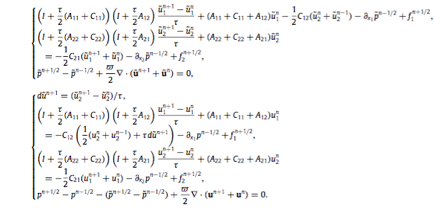Reports: ND955484-ND9: Efficient Numerical Techniques for Modelling of Surfactant-Laden Interfacial Phenomena
Petar D. Minev, PhD, University of Alberta
Here A11, C11, A21 are second order derivatives in the x spatial direction, A12, A22, C22 are derivatives in the y-direction, and C12, C21 are mixed second derivatives. This is a second order 2D scheme that has a straightforward extension to the 3D case as well. The code has been tested and verified. Currently we are working on the implementation of a level set, interface-capturing algorithm for solving free boundary problems. Proposed by Olsson and Kreiss (2005). The plan is to finalize the tests at the end of August 2016. I am also waiting for the arrival of a new postdoc that will greatly accelerate the work on the project. He was made an offer at the beginning of May 2016, however, due to a visa issue, has not started yet.
References:
J.L. Guermond and P. Minev, A new class of massively parallel direction splitting for the incompressible Navier-Stokes equations. Comp. Meth. Appl. Mech. Engng., 200 (2011), 2083-2093.
J.L. Guermond and P. Minev, High-order time stepping for the Navier-Stokes equations with minimal computational complexity. J. Computational and Applied Mathematics, in press.
E. Olsson, G. Kreiss, A conservative level set method for two phase flow, J. Comp. Phys., 210 (2005), 225-246.












